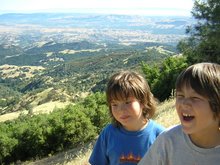 Not since the glaciers pushed toward these ridgelines a million years ago have the Appalachian Mountains been as threatened as they are today. But the coal-extraction process decimating this landscape, known as mountaintop removal, has generated little press beyond the region. The problem, in many ways, is one of perspective. From interstates and lowlands, where most communities are clustered, one simply doesn't see what is happening up there. Only from the air can you fully grasp the magnitude of the devastation. If you were to board, say, a small prop plane at Zeb Mountain, Tennessee, and follow the spine of the Appalachian Mountains up through Kentucky, Virginia, and West Virginia, you would be struck not by the beauty of a densely forested range older than the Himalayas, but rather by inescapable images of ecological violence.
Not since the glaciers pushed toward these ridgelines a million years ago have the Appalachian Mountains been as threatened as they are today. But the coal-extraction process decimating this landscape, known as mountaintop removal, has generated little press beyond the region. The problem, in many ways, is one of perspective. From interstates and lowlands, where most communities are clustered, one simply doesn't see what is happening up there. Only from the air can you fully grasp the magnitude of the devastation. If you were to board, say, a small prop plane at Zeb Mountain, Tennessee, and follow the spine of the Appalachian Mountains up through Kentucky, Virginia, and West Virginia, you would be struck not by the beauty of a densely forested range older than the Himalayas, but rather by inescapable images of ecological violence. On Thursday, I will fly in a small plane in eastern Kentucky to view the results of our insatiable need for electricity and all the comfort, power, and riches it brings.
 The top paragraph is from Erik Reeces article in the new Orion Magazine, which you can see here along with photos of the region by Antrim Caskey. Reece's LOST MOUNTAIN: Radical Strip Mining and the Devastation of Appalachia just came out last month.
The top paragraph is from Erik Reeces article in the new Orion Magazine, which you can see here along with photos of the region by Antrim Caskey. Reece's LOST MOUNTAIN: Radical Strip Mining and the Devastation of Appalachia just came out last month. Demands on Appalachian coal, millions of tons of which sit beneath the forested mountains of this impoverished part of the country -- poor largely because of this extractive industry -- grow greater every day with the expansion of the economies of China and India, and the rise in oil prices.
What is the answer? Insatiable desire (need?) versus ravaged lands and lives? Who wins may, in part, be up to you and me. Great, huh?




No comments:
Post a Comment